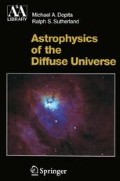Abstract
The discussion of the previous chapter has established the way in which emission lines may be produced by collisional excitation locally within a nebula. However, whether the observer can see the emission depends upon whether the nebula is optically thick or optically thin to the escape of this radiation. This in turn depends upon the optical depth, τ ν , of the nebula at the frequency ν. For transmission of light through an absorbing screen of material, the optical depth is defined by the factor by which the intensity of the radiation has been reduced, I(ν)/I 0 (ν) = exp(- τ ν ). The optical depth is the integral along the line of sight of the linear absorption coefficient (cm-1) \( k(s,v);{\tau _v} = \int {k(s,v)ds} \) . However a more useful measure is the mass absorption coefficient (cm2g-1), κ ν , which measures the effective cross section contributed per unit mass of matter at this frequency, κ ν = κ(s,ν)/ρ(s). This is also called the opacity of matter. Matter may either scatter light (re-radiation at the same frequency) or absorb it at one frequency and re-radiate at another. We must therefore recognize that the total opacity is the sum of these two contributions κ ν = κ ν (scat) + κ ν (abs). Absorption is produced by either dust, nebular continuum processes, or by fluorescence (degradation of the original photon into two or more photons, which occurs when the excited state of the atom has more than one permitted decay route). Scattering can be produced by dust, free electrons, or by resonant scattering in lines.
“There are no such things as applied sciences, only applications of science”
— Louis Pasteur
Access this chapter
Tax calculation will be finalised at checkout
Purchases are for personal use only
Preview
Unable to display preview. Download preview PDF.
Author information
Authors and Affiliations
Rights and permissions
Copyright information
© 2003 Springer-Verlag Berlin Heidelberg
About this chapter
Cite this chapter
Dopita, M.A., Sutherland, R.S. (2003). Line Transfer Effects. In: Astrophysics of the Diffuse Universe. Astronomy and Astrophysics Library. Springer, Berlin, Heidelberg. https://doi.org/10.1007/978-3-662-05866-4_4
Download citation
DOI: https://doi.org/10.1007/978-3-662-05866-4_4
Publisher Name: Springer, Berlin, Heidelberg
Print ISBN: 978-3-642-07771-5
Online ISBN: 978-3-662-05866-4
eBook Packages: Springer Book Archive

